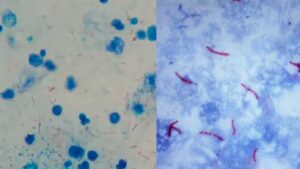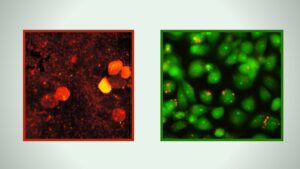Paul Ehrlich first introduced Ziehl–Neelsen staining, a form of acid-fast stain. The Ziehl–Neelsen stain is a bacteriological stain utilised to identify acid-fast organisms, primarily Mycobacteria. It is named for the bacteriologist Franz Ziehl (1859–1926) and the pathologist Friedrich Neelsen, who modified the stain (1854–1898).
What is Ziehl-Neelsen staining (ZN Staining)?
Ziehl-Neelsen Staining is a type of acid-fast staining technique, and it is another important differential staining procedure used to differentiate between acid-fast and non-acid fast bacteria. You must be thinking what is acid-fast staining? It is a staining procedure that differentiates between bacteria based on their ability to retain a dye when washed with an acid alcohol solution. It mainly differentiates between acid-fast and non-acid-fast bacteria.
This acid fast staining method is used to identify Mycobacterium tuberculosis and M. leprae. These two pathogens are responsible for tuberculosis and leprosy, respectively. They posses a lipid-containing cell wall, made of mycolic acid, a group of branched-chain hydroxy fatty acids, this prevent the binding of dye with the cell wall.
In Ziehl-Neelsen Staining we use a high concentration of phenol and carbol fuchsin, as well as a wetting agent, to drive the stain carbol fuchsin into mycobacterial cells. Once this dye has entered, the cells are not readily decolorized by acidified alcohol (acid-alcohol) and thus are said to be acid-fast. Non-acid-fast bacteria are readily decolorized by acid alcohol and thus are stained another color by a second dye called a counterstain.
This staining method was first introduced by Paul Ehrlich and modified by two German doctors Franz Ziehl (bacteriologist) and Friedrich Neelsen (pathologist).
Robert Koch discovered the cause of tuberculosis in 1882. Paul Ehrlich created the alum hematoxylin stain for mycobacterium tuberculosis shortly after Koch’s discovery. Franz Ziehl then modified Ehrlich’s method of staining by using carbolic acid for the mordant. Friedrich Neelsen retained Ziehl’s choice of mordant but replaced the principal stain with carbol fuchsin. Together, Ziehl and Neelsen’s adjustments have produced the Ziehl–Neelsen stain. Joseph Kinyoun created a second acid-resistant stain by omitting the heating stage from the Ziehl–Neelsen staining method. The Kinyoun stain is the name of this new stain.
Objective of Ziehl-Neelsen Staining (ZN Staining)
The main objective of this stinging method is to differentiate between the acid-fast and non-acid fast bacteria. It also used to stain Mycobacterium species.
Ziehl-Neelsen stain principle (ZN Staining principle)
The cell wall acid-fast bacteria contain waxy mycolic acid, which is relatively impermeable to simple stains. But when the heat and Carbol fuchsin applied, the cell’s waxy mycolic acid layer become weaken and porous, thus the carbol fuchsin penetrates the cell wall.
When we applied heat, it softens the cell wall and permit the stain( carbol fuchsin) to penetrate it. Carbol fuchsin is more soluble in phenol as compared to alcohol and water, in turn, phenol is more soluble in lipid or wax, thus the phenol and fuchsin mixture easily enters the cell.
The cells are now decolorized by a decolorizer containing sulfuric acid or Hydrochloric acid. Thus, those bacteria are decolorized and appear colorless, are considered as Non Acid- fast bacteria, and those are do not get decolorized are known as acid-fast bacteria.
The non-acid fast bacteria easily resist the decolorization, this is because, phenol dye mixture is more soluble in waxy mycolic acid as compared to the acid or alcohol. In this way phenol act as a mordant.
After completion of decolorization, the acid-fast bacteria appear in red or pink color, while the non-acid fast bacteria appear colorless. Now, a counterstain or secondary stain (Methylene blue) is applied to visualize the non-acid fast bacteria, they retain the color of counterstain (Methylene blue) and appear in blue.
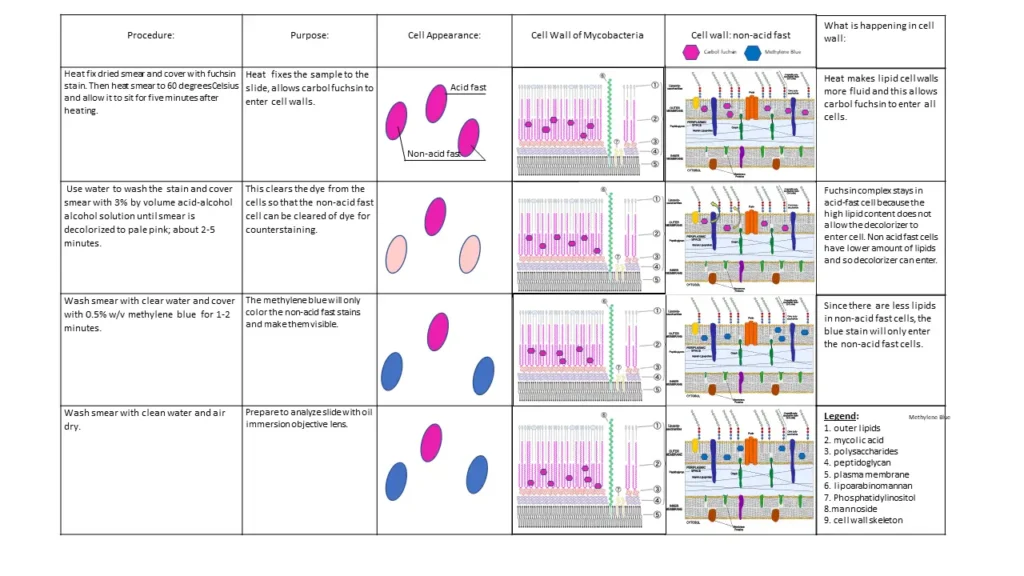
Requirement of Ziehl-Neelsen Staining
Culture and Instruments: Bacterial culture/ Sputum sample, Glass Slide, Microscope, Wash bottle, Distilled water, Inoculating loop, Spirit lamp / Bunsen burner.
Reagents:
- Primary Stain: Carbol fuchsin stain (mixture of 100ml Distilled water, 1g Basic fuschin, 10ml of 100% Ethyl alcohol, and 5ml Phenol crystals)
- Decolourizer: 20% sulphuric acid or acid-alcohol (Mixture of 95ml of 95% Ethyl alcohol, 2ml Distilled water, 3ml of 3% Concentrated hydrochloric acid)
- Counterstain: methylene blue (mixture of 0.25g Methylene blue, 99ml Distilled water, and 1ml Acetic acid).
Preparation of stains for Ziehl-Neelsen staining (ZN Staining)
Coloring agent solutions
Ziehl’s carbol fuchsin (solution A)
- 3% alcoholic fuchsin stock solution
- Basic fuchsin —— 3 g
- Alcohol 95% ——- up to 100 ml
- Place the needed amount of fuchsin in a graduated flask (or cylinder) and add enough ethanol or methyl alcohol to achieve a total volume of 100 ml. Shake vigorously until the fuchsin is dissolved.
- Before colouring, small portions of this solution must be filtered.
Aqueous solution of phenol (solution B)
| Phenol crystals | 5 g |
| Distilled water, if possible | up to 90 ml |
Before adding water, slightly heat the phenol crystals in a flask to dissolve them.
To make the working solution for Ziehl’s carburized fuchsin, combine 10 ml of solution A with 90 ml of solution B.
Bleaching agent solutions
Alcohol-acid solution
| Alcohol 95% | 970 ml |
| Concentrated hydrochloric acid (35%) | 30 ml |
Or when alcohol is not available:
25% aqueous sulfuric acid solution:
| Water, distilled if possible | 300 ml |
| Concentrated sulfuric acid | 100 ml |
Pour 300 millilitres of water into a one-liter Erlenmeyer flask. Slowly pour 100 ml of pure sulfuric acid down the edge of the flask as you add it. The mixture will become heated.
Never add water to concentrated sulfuric acid, as this can result in an explosive splash.
Methylene blue counter-stain solution
| Methylene blue chloride | 0.3 g |
| Water, distilled if possible | up to 100 ml |
Ziehl Neelsen Stain Steps/Procedure
Smear preparation
- Take a grease-free slide.
- Sterilize the inoculating loop by using a bunsen burner. Hold it on flame until it becomes hot red.
- Use the sterile loop to transfer a loop full culture on the slide, and then prepare the smear.
- Dry the smear in the air.
- Heat-fix the dried smear, by passing it through the flame of bunsen burner.
Acid-fast staining Procedure
- Spread the sputum equally over the blade’s core surface with a continuous rotating motion; we recommend a spread of approximately 20 mm by 10 mm.
- Place the slides on the dryer with the spreading surface facing up and let approximately 30 minutes for air drying.
- Restore the dried slides by gripping them with pliers and passing them over a flame five times for approximately four seconds with the spreading side facing the flame. Do not dry wet boards with heat and avoid overheating.
Staining
- Place the fixed slides on the staining rack, spreading side up, according to their order number. The blades should be separated by 1 cm and never come into contact with one another.
- Cover the slides sequentially with filtered Ziehl’s 0.3% carbolic fuchsin working solution.
- By inserting a strip of absorbent paper, such as filter paper or even newspaper, the staining solution will be preserved and fuchsin crystals will not form on the smear.
- Using the flame of a Bunsen burner, alcohol lamp, or cotton ball soaked in alcohol, heat the slides from below until steam is produced. The colourant solution must never be boiled. Avoid letting the dye dry out.
- Cover the slides with a hot and steaming solution of carbolic fuchsin for five minutes, if required ironing the flame.
- Water-rinse the slides gently to eliminate excess carbol fuchsin.
- Drain the surplus water from rinsing the slides. Sputum stains are coloured red.
Discoloration
- After three minutes of exposing the slides to a 25% sulfuric acid or alcohol acid solution and allowing it to function, the red tint should have mostly faded. If required, repeat this procedure for an additional two minutes.
- Water should be used to gently remove sulfuric acid, alcohol-acid, and excess food colouring. Remove any surplus water from the slides.
Counterstaining
- Cover the slides one by one with the counterstaining solution (0.3% methylene blue) and let 1 minute for the solution to take effect.
- Rinse each slide separately with water
- Drain the water and let the slides to air dry.
The look of a properly stained smear under the influence of methylene blue is light blue. If the hue is dark blue, the smear is excessively thick; a text cannot be read through the slide under these conditions.
| Reagent | Acid Fast | Non-Acid Fast |
| Carbol Fuchsin with heat | Red (Hot Pink) | Red (Hot Pink) |
| Acid Alcohol | Red | Colorless |
| Methylene Blue/Malachite Green | Red | Blue/Green |
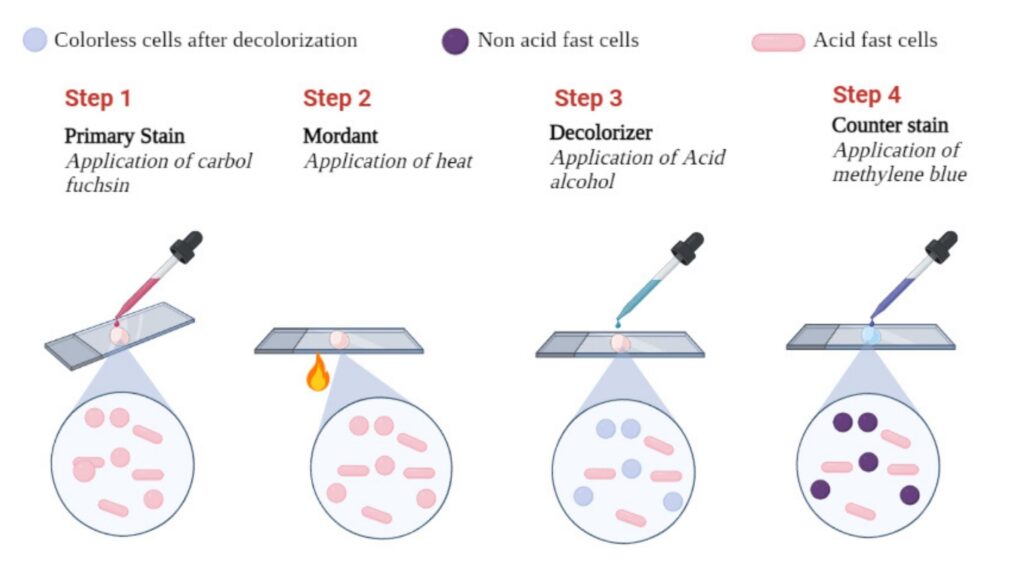
Result of Ziehl-Neelsen Staining or acid-fast staining
- Acid-fast bacteria: These bacteria retain the color of primary stain, carbol-fuschin, and appear pink.
- Non-acid fast: They take the color of methylene blue dye and appear blue.
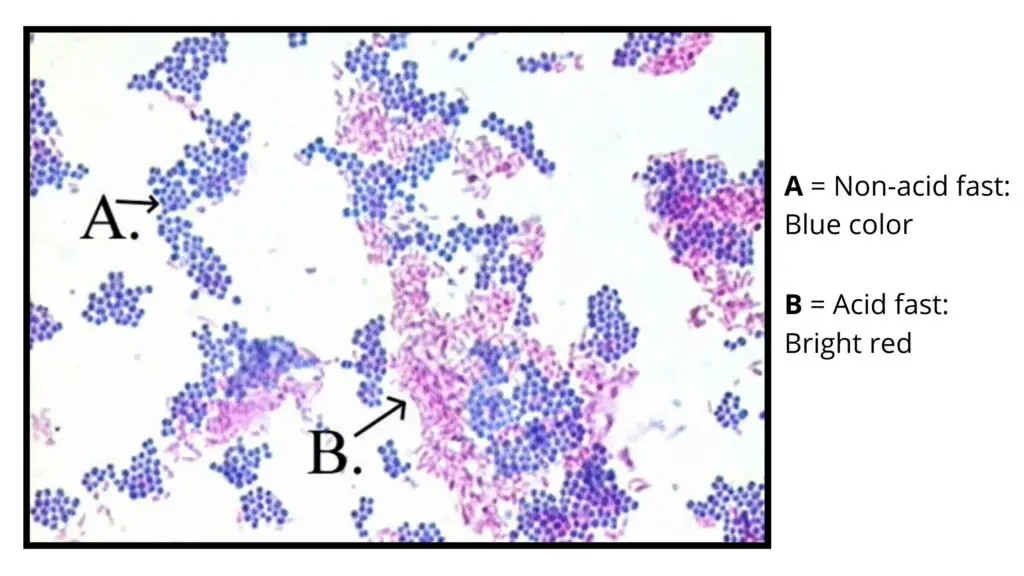

Modified Ziehl Neelsen Staining Technique
- The smear can be treated with 95% alcohol as a secondary decolorizer after the treatment with primary decolorizer, sulfuric acid. Because there are few microorganism, which has both acid-fast and alcohol fast characteristics, such as Mycobacterium tuberculosis. Whereas the saprophytic mycobacterium is only acid fast.
- 3% HCl and 95% alcohol can be used as a decolorizer instead of 20% sulfuric acid. This too distinguishes tubrcle bacilli from saprophytic mycobacteria. It is mainly used in the determination of renal tuberculosis.
- Modifications in the percentage of sulfuric acid; 5% H2SO4 for M.leprae, 1% H2SO4 for Actinomyces in tissue, 0.5% H2SO4 for cultures of Nocardia, 0.25-0.5% for spores and for oocysts of Cryptosporidium and Isospora,
- Where heating is not employed, we can use the cold method, by increasing the concentration of phenol and the duration of staining instead of heating (Kinyoun’s modification, Gabbett’s modification ).
Examples of Acid-fast
Nocardia spp (Partial Acid Fast), Rhodococcus spp (Partial Acid Fast), Legionella micdadei (Partial Acid Fast in tissue), Cyst of Cryptosporidium (Acid Fast), Cyst of Isospora (Acid Fast)
Applications of Ziehl-Neelsen Staining
- Tuberculosis diagnosis: Ziehl-Neelsen staining is commonly used to diagnose tuberculosis (TB) by identifying the presence of the bacterium Mycobacterium tuberculosis in sputum samples.
- Identification of other acid-fast bacteria: Ziehl-Neelsen staining is also used to identify other acid-fast bacteria such as Mycobacterium avium and Mycobacterium kansasii, which can cause infections in people with weakened immune systems.
- Research purposes: Ziehl-Neelsen staining is also used in research studies to identify the presence and distribution of acid-fast bacteria in various environmental samples.
- Quality control: Ziehl-Neelsen staining is used in the quality control of biological products, such as vaccines, to ensure that they are free from contamination by acid-fast bacteria.
- To identify some fungal species i.e Cryptosporidium.
- Can help differentiate and identify fungi ,i.e Histoplasma.
Limitations of Ziehl-Neelsen Staining
- It is exclusively applicable for identifying acid-fast bacilli.
- The organism’s physical form is distorted.
References
- https://www.microrao.com/micronotes/acidfast.htm
- https://paramedicsworld.com/microbiology-practicals/acid-fast-staining-principle-procedure-interpretation/medical-paramedical-studynotes
- https://microbeonline.com/ziehl-neelsen-technique-principle-procedure-reporting/
- https://labhelpline.com/2019/05/23/ziehl-neelsen-staining-technique-for-acid-fast-bacilli/
- https://www.uwyo.edu/virtual_edge/units/acidfast_stain.html
- https://www.ncbi.nlm.nih.gov/pubmed/17533853/
- https://www.differencebetween.com/difference-between-acid-fast-and-vs-non-acid-fast-bacteria/
- https://www.onlinebiologynotes.com/acid-fast-staining-ziehl-neelsen-technique/
- https://microbiologyinfo.com/acid-fast-stain-principle-procedure-interpretation-and-examples/
- https://www.carolina.com/specialty-chemicals-a/acid-alcohol-3-hydrochloric-acid-in-95-ethanol-laboratory-grade-500-ml/841733.pr
- http://whocctblab.fondazionesanraffaele.it/uploads/2/0/8/2/20828554/_ios_ebp-ziehl-neelsen_staining.pdf
- https://www.researchgate.net/post/Why_Are_Mycobacteria_Acid_Fast
- https://quizlet.com/145783763/microbiology-hw-quiz-flash-cards/
- https://en.wikipedia.org/wiki/Kinyoun_stain
- https://en.wikipedia.org/wiki/Acid-fastness
- https://en.wikipedia.org/wiki/Ziehl%E2%80%93Neelsen_stain
